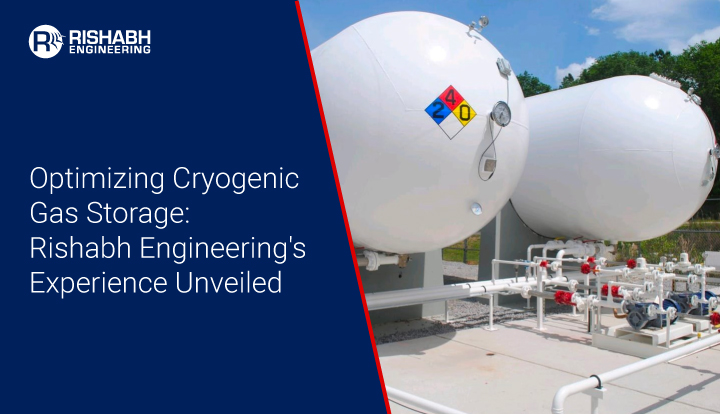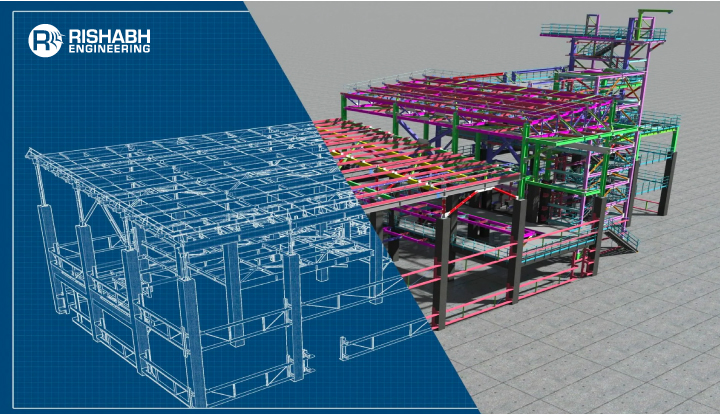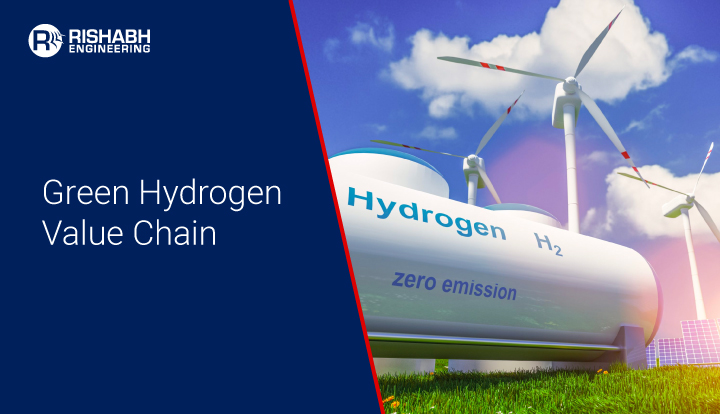
Cryogenic Gas Storage Challenges: Multidisciplinary Engineering Perspective
In the dynamic landscape of industrial gas storage, cryogenic containers play a pivotal role in ensuring the safe and efficient storage of gases at extremely low temperatures. Cryogenic storage is crucial in transporting gases at extremely low temperatures. These containers, designed to handle the unique challenges of cryogenic conditions, are essential in the healthcare and energy industries. However, cryogenic gas storage challenges are multifaceted, demanding specialized engineering solutions. This is where a specialized multidiscipline engineering company can help address the particularities of cryogenic containers for gas storage.

In this blog post, we’ll explore the unique challenges with cryogenic storage and how Rishabh Engineering, with its specialized expertise, can effectively address the particularities of cryogenic containers for gas storage.
Challenges With Cryogenic Gas Storage & How to Resolve It
Cryogenic containers, designed to store gases below -150°C (-238°F), present challenges distinct from conventional storage systems. The low temperatures can lead to material embrittlement, thermal stress, and other operational complexities. Cryogenic containers, designed for storing and transporting gases at ultra-low temperatures, present unique challenges. The material used to create these containers must withstand extreme cold, and the engineering solutions must ensure the container’s integrity while optimizing efficiency and safety. Moreover, managing heat transfer, insulation, and pressure demands a comprehensive understanding of various engineering disciplines.
Let’s discuss them in detail;
1. Role of Materials Engineering: Materials engineering is at the forefront of addressing the challenges posed by cryogenic containers. Developing materials that can maintain structural integrity at low temperatures is crucial. Multidisciplinary engineering companies bring together materials scientists and mechanical engineers to design alloys and composites capable of withstanding extreme cold without compromising the container’s strength. Innovative materials, such as advanced polymers and superalloys, are being explored to enhance cryogenic containers’ thermal and mechanical properties.
Multidisciplinary teams collaborate to analyze material behavior under different cryogenic conditions, ensuring that the chosen materials meet the stringent requirements of durability, thermal conductivity, and corrosion resistance.
2. Thermal Engineering: Controlling heat transfer in cryogenic environments is a delicate dance. Thermal engineers are pivotal in designing systems that minimize heat ingress into the container while efficiently managing heat generated from stored gases. This involves the development of sophisticated insulation systems and thermal barriers.
Multidisciplinary engineering companies leverage the expertise of thermal engineers, working in tandem with materials engineers, to create insulation solutions that provide optimal thermal resistance. These solutions not only prevent heat leakage but also contribute to the overall efficiency of the cryogenic storage system, reducing energy consumption and operational costs.
3. Mechanical Engineering: The structural integrity of cryogenic containers is a critical aspect that requires a delicate balance between strength and flexibility. Mechanical engineers collaborate with materials scientists to design container structures that can withstand extreme cold without becoming brittle.
Multidisciplinary teams ensure that cryogenic containers maintain their structural integrity even in the harshest conditions by incorporating innovative design concepts, such as composite materials and advanced fabrication techniques. Rigorous testing and simulation methodologies are employed to analyze the mechanical behavior of containers under different loads and temperatures, providing valuable insights into their performance and reliability.
4. Safety Engineering: Safety is paramount in cryogenic gas storage. The multidisciplinary approach extends to safety engineering, where experts work to identify and mitigate potential risks associated with cryogenic containers. This includes the development of fail-safe mechanisms, emergency response plans, and thorough risk assessments. Collaboration between safety engineers, materials experts, and thermal engineers results in implementing redundant safety features, ensuring that any unforeseen events are addressed promptly and effectively.
Multidisciplinary engineering companies prioritize safety as an integral part of the design and operation of cryogenic storage systems, minimizing the likelihood of accidents and ensuring the protection of personnel and assets.
5. Automation and Control Systems: In the era of Industry 4.0, integrating automation and control systems is transforming cryogenic gas storage. Automated control systems enable precise regulation of temperature, pressure, and other critical parameters, optimizing the performance of cryogenic storage facilities. Moreover, the integration of sensors and data analytics enhances predictive maintenance, reducing downtime and improving overall operational efficiency.
Multidisciplinary engineering companies incorporate electrical, control, and software engineering expertise to develop intelligent systems that monitor and control various aspects of cryogenic containers in real-time.
6. Environmental Considerations: Environmental engineers collaborate with other disciplines to implement eco-friendly solutions, ensuring that cryogenic containers adhere to sustainability principles. This holistic approach not only aligns with global environmental goals but also enhances the reputation of companies as responsible corporate citizens.
Multidisciplinary engineering also addresses the environmental impact of cryogenic gas storage. Sustainable practices, such as optimizing energy consumption, recycling materials, and reducing greenhouse gas emissions, are integral to the design and operation of cryogenic storage systems.
How Can Rishabh Engineering Help Address Cryogenic Storage Challenges?
We are an experienced detailed engineering services company providing comprehensive solutions for cryogenic gas storage. With a structured approach, our team of specialist materials, thermal, mechanical, and safety engineers collaborate seamlessly to design cryogenic containers. We ensure structural integrity, thermal efficiency, and safety in cryogenic storage systems by leveraging advanced materials and innovative insulation technologies. Further, our proficiency in automation and control systems helps optimize operational performance. With a proven track record, Rishabh Engineering offers tailored solutions that meet and exceed cryogenic gas storage’s stringent requirements, providing clients with reliable, efficient, and environmentally responsible solutions.
Key Considerations To Avoid Challenges Of Cryogenic Containers:
1. Finite Element Analysis (FEA) takes center stage in assessing the structural integrity of cryogenic storage vessels. Engineers employ FEA to simulate and analyze the effects of extreme temperatures on materials, ensuring that the storage infrastructure can withstand the demanding conditions. This comprehensive analysis allows for the optimization of structural design, minimizing risks associated with thermal stresses and ensuring long-term durability.
2. Computational Fluid Dynamics (CFD) is another vital tool in the multidisciplinary engineer’s arsenal. It enables the study of fluid flow patterns and heat transfer within cryogenic storage systems. By employing CFD simulations, engineers can gain insights into thermal management, identify potential hotspots, and optimize insulation strategies to prevent cryogenic fluids from warming prematurely.
3. Pipe Stress Analysis is indispensable in cryogenic gas storage projects, ensuring the integrity of the entire pipeline network. The extreme temperatures and pressure differentials involved necessitate a thorough analysis of piping systems to avoid leaks, structural failures, or thermal-induced stresses. Rigorous pipe stress analysis helps in selecting appropriate materials, ensuring compliance with safety standards, and optimizing the overall system performance. Do read this blog to explore the major hurdles in piping stress analysis for cryogenic systems that engineers encounter on a routine basis.
4. Tank Instrumentation Considerations are equally critical in cryogenic gas storage. Accurate monitoring and control of temperature, pressure, and fluid levels are paramount for the safe and efficient operation of storage tanks. Engineers integrate advanced instrumentation systems to provide real-time data, enabling precise control and swift response to any deviations from optimal conditions.
5. Finally, the Location, Size, and Shape of cryogenic gas storage facilities help decide the geographical placement and must adhere to safety regulations and environmental factors. This is while ensuring minimal risk to surrounding areas. Further, the optimal sizing and shaping of storage vessels contribute to efficient space utilization and cost-effectiveness, reflecting the holistic approach necessary for successful cryogenic gas storage projects.
Success Story
Case 1: Piping Stress Analysis of Vacuum Jacketed Liquid Nitrogen Lines
A leading North American cryogenic gas equipment and systems manufacturer wanted to conduct pipe stress analysis for vacuum-jacketed liquid nitrogen lines. They were seeking help from a dedicated engineering service partner for one of their existing facilities, which has a design temperature of -320°F and pressure of 200 PSIG.
Design Parameters:
| Parameters | Value |
| Total Piping Systems | 25 |
| Total Number of Lines | 25 |
| Max. Pipe Diameter | 6″ |
| Max. Temperature | -320oF |
| Max. Pressure | 200 PSIG |
Case 2: 3D Modeling of LIN Storage and Vaporization Packages
An Asia-based manufacturer of Cryogenic liquid storage and transport tanks was in pursuit of a multidiscipline engineering services provider to support them with creating 3D model of liquid nitrogen storage and vaporization packages for the station. This required careful consideration of equipment, piping, pipe supports, cable tray routing, and mounted instrumentation.
The project scope covered;
- 3D modeling for a LIN storage and vaporizer skid
- Equipment modeling
- Modeling of structural platforms like ladders, utility holes, envelopes
- Piping modeling (25 nos. of lines)
- Skid structural modeling
- Physical support modeling
- Modeling of instruments, junction boxes with supports
Final Words
Rishabh Engineering stands out as a reliable partner with a proven track record in cryogenic gas storage. Their customized design solutions, material expertise, advanced insulation techniques, and commitment to safety make them a go-to choice for industries relying on cryogenic containers. As the demand for cryogenic storage solutions continues to rise, Rishabh Engineering’s dedication to innovation and excellence positions them at the forefront of addressing the particularities of cryogenic containers for gas storage.
Seek Help With Managing Cryogenic Storage Design Challenges?
We can ensure structural integrity, thermal efficiency, safety, and environmental responsibility in addressing cryogenic gas storage challenges.
Related Blogs
Related Blogs
Best Structural Engineering Software for Accurate Analysis
Finding tools that simplify and improve the accuracy of the…
Detailed Engineering Considerations for Project Success
Engineering projects today require meticulous planning and execution across various…


